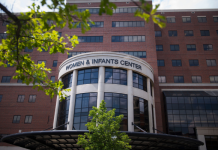
Chances are you know someone who’s had preeclampsia, or you’ve had it yourself. The fear of preeclampsia weighs heavily on many pregnant women, but what exactly is it? Thankfully Dr. Rachel Sinkey of the Maternal and Fetal Medicine (MFM), Obstetrics and Gynecology (OB/GYN) Department of UAB Medicine is with Birmingham Mom Collective today to help us better understand this condition. As a Maternal-Fetal Medicine physician and researcher, Dr. Sinkey is well aware of the risks and treatments for preeclampsia.
What is Preeclampsia?
Preeclampsia is a high blood pressure problem in the last half of pregnancy. Symptoms include elevated blood pressure, often with protein in the pregnant mother’s urine. Other symptoms such as headaches, changes in vision, and abdominal pain often occur. Preeclampsia can also be accompanied by organ damage to the liver and kidneys.
When Does Preeclampsia Occur?
Preeclampsia occurs in the second half of pregnancy, and it’s most commonly seen later in the third trimester.
Can Preeclampsia Be Prevented?
No. However, if high-risk patients take a baby aspirin once a day starting in the latter part of the first trimester or early second trimester, the risk can be reduced.
How Common Is Preeclampsia?

Preeclampsia occurs in up to 8% of pregnancies.
However, it occurs along a continuum ranging from gestational hypertension (new onset hypertension in the second half of pregnancy) to preeclampsia (new hypertension plus protein in mom’s urine or severe hypertension and/or organ damage).
When gestational hypertension is included, it affects about 13% of U.S. pregnancies.
UAB Medicine’s Treatment for Preeclampsia
The safest thing for a mother with preeclampsia is to deliver. However, that is not always the safest thing for the baby. So, UAB often carefully monitors a preterm mother with preeclampsia in order to keep mom safe while allowing the baby to grow longer to reduce the effects of prematurity.
UAB Medicine uses a team approach of OB/GYN, MFMs, and neonatologists to keep mom safe while also monitoring the fetus. When it is time to deliver, the neonatologists and pediatricians do a fantastic job providing care to the babies until they are able to safely go home with their families.
Future Preeclampsia Prevention
Dr. Sinkey says pregnancy is considered a stress test to the body. Preeclampsia is associated with a two to four times increased risk of future heart disease for the mother.

For mothers who’ve had preeclampsia, she recommends they see their primary care doctor within six months to one year following childbirth. This appointment is a great time to discuss ways to reduce the risk of future heart disease including keeping blood pressure at normal levels, making sure lipids are normal, detecting and treating diabetes, keeping a healthy weight, and exercising.
For more information about preeclampsia, Dr. Sinkey recommends this website. Thank you, Dr. Sinkey, for sharing your knowledge and expertise with us today!











